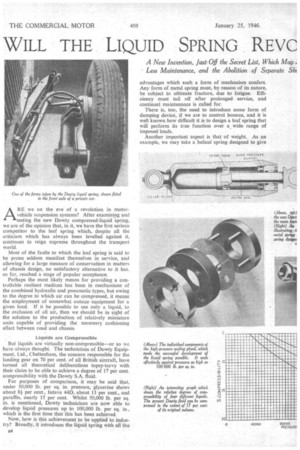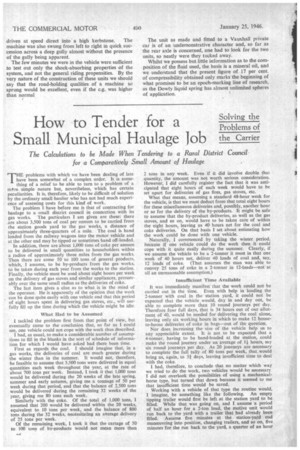WILL THE LIQUID SPRING REVC
Page 30

Page 31

Page 32

If you've noticed an error in this article please click here to report it so we can fix it.
1UTIONIZE January 25, 1946.
VEHICLE SUSPENSION?
ARE we on the eve of a revolution in motorvehicle suspension systems? After examining arid testing the new Dowty compressed-liquid -spring, we are of the opinion that, in it, we have the first serious competitor to the leaf spring which, despite all the criticism which has always been levelled against it, continues to reign supreme throughout the transport world.
Most of the faults to which the leaf spring is said to be prone seldom manifest themselves in service, and allowing for a large measure of conservatism in matters of chassis design, no satisfactory alternative to it has. so far, reached a stage of popular acceptance.
Perhaps the most likely means for providing a Controllable resilient medium has been in mechanisms of the combined hydraulic and pneumatic types, but owing to the degree to which air can be compressed, it means the employment of somewhat outsize 'equipment for a given load. If it be possible to use only a liquid, to the exclusion of all air, then we should be in sight of the solution to the production of relatively miniature units capable of providing the necessary cushioning effect between road and chassis
Liquids are Compressible
But liquids are virtually non-compressible--or so we have always thought. The technicians of Dowty Equipment, Ltd., Cheltenham, the concern responsible for the landing gear on 70 per cent, of all British aircraft, have turned all theoretical deliberations topsy-turvy with their claim to be able to achieve a degree of 17 per cent. compressibility with the Dowty S.A. fluid.
For purposes of comparison, it may be said that, under 50,000 lb. per sq. in. pressure, glycerine shows about 8i per cent., Iritava 44D, about 13 per cent., and paraffin, nearly 15 per cent. Whilst 50,000 lb. per sq. in. is mentioned, Dowty technicians are now able to develop liquid pressures up to 100,000 lb. per sq. in., which is the first time that this has been achieved.
Now, how is this achievement to be applied to indus. try? Broadly, it introduces the liquid spring with all the 134 advantages which such a form of mechanism confers. Any form of metal spring must, by reason of its nature, be subject to ultimate fracture, due to fatigue. Efficiency must tail off after prolonged service, and continual maintenance is called for.
There is, too, the need to introduce some form of damping device, if we are to control bounce, and it is well known how difficult it is to design a leaf spring that will perform its true function over a, wide range of imposed loads.
Another important aspect is that of weight. As an example, we may take a helical spring designed to give a maximum deflection of 4 ins, under an imposed load of 20 tons. The maximum diameter of a suitable metal spring would be 10i ins,, whereas that of the liquid spring would be 3:t ins., with respective weights of 125 lb. and 21 lb.
High efficiency and low cost usually go hand in hand with simplicity, and we do not think that there could be a mechanism more simple than the Dowty liquid spring_ It was not designed overnight, however, as it took about three years to evolve an effective sealing gland; and something like £50,000 has been spent in experimental and research work in connection with it. Reference to the accompanying illustrations will show that there is a minimum number of parts and that these are straightforward and robust in design. The Dowty liquid spring comprises a cylinder, piston, piston rod and a sealing gland. There is little in the cylinder itself except that, as will be seen, the area in which the piston moves is of larger diameter than the unswept section The metal used is a high-tensile steel. A relatively shallow piston is employed, in which there is a spring loaded ball valve and a straight-through port. The action of the ball valve will be obvious, and its purpose is to create a damping or shock-absorber effect.
The Sealing Gland It was the successful development of the sealing gland which made the Dowty liquid spring a practical proposition, as whilst the mere sealing of the piston rod might not present a great difficulty, retaining smooth action of the rod running through the sealing gland. certainly did.
The gland adopted is of the unsupported-area type, and is located between a step in the cylinder bore and the gland-retaining nut. It has three main sections, comprising a steel pressure plate, which carries four dowel pins, a resilient gland ring and a backing plate. Between the gland ring and pressure plate there is a foraminated disc, the purpose of which is to prevent a pressure lock.
It should be noted that the cross-sectional area of the resilient gland is less than that of the pressure plate, owing to the existence of the four dowel holes in it This has the effect of intensifying the pressure on the gland, with the result that the resilient gland tends to " leak " into the cylinder rather than the oil to leak out It should be understood that whilst the piston makes a leak-proof seal with the cylinder wall, it is not the piston which produces the compressive effort, but the piston rod. As the rod is forced into the liquid, there is a controlled transference of fluid from one side of the piston to the other, the increase in pressure being directly proportional to the degree of entry of the od The application of such a spring to a chassis has been carried out by the Dowty concern, and we can say that we found the device to function in a most satisfactory manner when the vehicle on which it was fitted was driven at speed direct into a high kerbstone. The machine was also swung from left to right in quick succession across a deep gully almost without the presence of the gully being apparent.
The few minutes we were in the vehicle were sufficient to test out only the shock-absorbing properties of the system, and not the general riding propensities. By the very nature of the construction of these units we should say that the road-holding qualities of a machine so sprung would be excellent, even if the e.g. was higher than normal The unit as made and fitted to a Vauxhall private car is of an undemonstrative character and, so far as the rear axle is concerned, one had to look for the two units, so neatly were they tucked away.
Whilst we possess but little information as to the composition of the fluid used, the basis is a mineral oil, and we understand that the present figure of 17 per cent. of compressibility obtained only marks the beginning of what promises to be an epoch-marking line of research, as the Dowty liquid spring has almost unlimited spheres of application.




























































